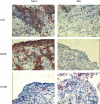Early effects of tumour necrosis factor alpha blockade on skin and synovial tissue in patients with active psoriasis and psoriatic arthritis
- PMID: 15194570
- PMCID: PMC1755073
- DOI: 10.1136/ard.2003.018085
Early effects of tumour necrosis factor alpha blockade on skin and synovial tissue in patients with active psoriasis and psoriatic arthritis
Abstract
Background: Tumour necrosis factor alpha (TNFalpha) blockade using infliximab, a chimeric anti-TNFalpha antibody, is an effective treatment for both psoriasis and psoriatic arthritis (PsA).
Objective: To analyse the early effects of infliximab treatment on serial skin and synovial tissue biopsy samples.
Methods: Twelve patients with both active psoriasis and PsA received a single infusion of either infliximab (3 mg/kg) (n = 6) or placebo (n = 6) intravenously. Synovial tissue and lesional skin biopsy specimens were obtained at baseline and 48 hours after treatment. Immunohistochemical analysis was performed to analyse the inflammatory infiltrate. In situ detection of apoptotic cells was performed by TUNEL assay and by immunohistochemical staining with anti-caspase-3 antibodies. Stained tissue sections were evaluated by digital image analysis.
Results: A significant reduction in mean (SEM) T cell numbers was found in both lesional epidermis (baseline 37 (11) cells/mm, 48 hours 26 (11), p = 0.028) and synovial tissue (67 (56) cells/mm(2)v 32 (30), p = 0.043) after infliximab treatment, but not after placebo treatment (epidermis 18 (8) v 43 (20), NS; synovium 110 (62) v 46 (21), NS). Similarly, the number of macrophages in the synovial sublining was significantly reduced after anti-TNFalpha treatment (100 (73) v 10 (8), p = 0.043). The changes in cell numbers could not be explained by induction of apoptosis at the site of inflammation.
Conclusions: The effects of anti-TNFalpha therapy in psoriasis and psoriatic arthritis may be explained by decreased cell infiltration in lesional skin and inflamed synovial tissue early after initiation of treatment.
Figures


References
Publication types
MeSH terms
Substances
LinkOut - more resources
Full Text Sources
Other Literature Sources
Medical
Research Materials
Miscellaneous

